
Sundari’s recent post, addressing the portayal of Sikhs in an ad for the upcoming Spinning Wheel festival, brings up an interesting tension for Sikh women- the conflict between modern ideals of beauty, and the requirements of the Sikh faith.
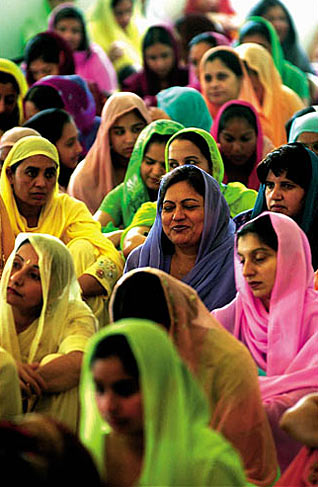 Generally (and unfortunately) women tend to value themselves (whether consciously or unconsciously) according to social valuations placed upon women… which revolve mostly around ideas of outer beauty- trends which vary a bit across region and time, but are all generally superficial. Women who have completely overcome this unconscious embrace of ideals of beauty are extremely rare. For those who think is untrue- think about how many times you’ve heard a female friend talk about the bad day she was having- many of the complaints probably had something to do with the way she felt she looked that day (that might not be the best example, but it’s the first that comes to mind). How we feel is too closely related to how we feel we look.
Generally (and unfortunately) women tend to value themselves (whether consciously or unconsciously) according to social valuations placed upon women… which revolve mostly around ideas of outer beauty- trends which vary a bit across region and time, but are all generally superficial. Women who have completely overcome this unconscious embrace of ideals of beauty are extremely rare. For those who think is untrue- think about how many times you’ve heard a female friend talk about the bad day she was having- many of the complaints probably had something to do with the way she felt she looked that day (that might not be the best example, but it’s the first that comes to mind). How we feel is too closely related to how we feel we look.
These social valuations of beauty are especially problematic for Sikh women in particular because these values are totally opposed to an important part of Sikh identity- our kesh. They are also problematic for all women because we’re not valuing what really matters- our thoughts, ideas and actions which really create who we are- but a superficial farce. Finally, these valuations are problematic because many modern ideals of beauty are unhealthy (but enough has been said about these last two points in general gender conversations that I don’t want to dwell on them).
The challenges and overt racism that Sikh men face in the US today because of their kesh are undeniable. But the solutions that address men’s kesh (mostly political responses, creating social awareness) don’t carry over as solutions for women.
Only every so often I come across a petition in my inbox which advocates for an issue that I feel strongly about. I find myself more than happy to take the few minutes required to click on the links and add my name to the “Undersigned.” 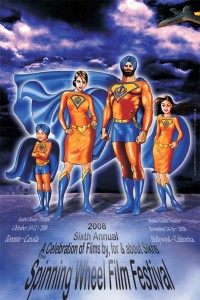 A few days ago, I was sent another such petition, but to be quite honest I didn’t quite know what to make of it.
A few days ago, I was sent another such petition, but to be quite honest I didn’t quite know what to make of it.
The petition, drafted in response to an advertisement for the upcoming Spinning Wheel Film Festivals, states that the “superhero” image being used depicts Sikhs in a negative manner. The author(s) suggest that the characters shown in the poster are portrayed in ways that go against the Sikh Rehat Maryada and Gursikh principles.
The current poster diminishes Sikh identity by playing fast and loose with Sikh Rehat Maryada in presenting the lead male and female characters as superheroes and role models. They appear more as villains, abandoning the true Sikh virtues. Going about “saving the world” with the hair uncovered is far from being obedient to Sikh Rehat and to the visible identification as a Gursikh. The Kirpan is supposed to be worn in a Gatra, not attached to a belt. Furthermore, pierced ears as in the case of the young girl are not in the spirit of how Sikhs should raise their children towards principled Sikh living.
I have my own opinions about the SWFF as it stands today, and although I was somewhat surprised by the choice of promotional material being used (from an aesthetic perspective) – I was much more intrigued about the nature and origin of the petition. I don’t know who authored the petition (does it matter?), but it brings up a much larger issue. The petition goes beyond a simple commentary of promotional material. The various comments left on the petition (even the incoherent ones) suggest that many individuals within our community still believe that Sikhs are only defined by certain external attributes:

“I don’t trust Obama. I have read about him and he’s an Arab.”
So said a McCain supporter at a recent rally. To such an ignorant, bigoted, racist comment, McCain could only reply:
“No, ma’am,” he said. “He’s a decent, family man, a citizen that I just happen to have disagreements with.”
McCain did not say that Arabs are decent people, instead we are left to infer that “Arabs” and “decent, family man” are somehow antonyms. Barack Obama should not be let off the hook either as he is just as complicit. Earlier when his Democrat primary opponents were trying to smear him, he distanced himself from being Arab and Muslim (which of course he is not!), but did not stop that conversation and say Arabs and Muslims are just as American as anyone else.
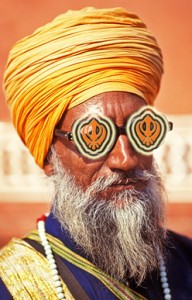 Has anyone else noticed how ridiculous the (US Presidential Election) campaigns have gotten? The ridiculousness has reached a new all time low in the past few weeks with both sides slinging mud, making tenuous connections, and outright lying. Admittedly, I have a preference for one side over the other, but like most people nowadays that means less than it used to and I have truly tried to be “fair” in my analysis of recent politicking. What I have seen from both sides makes me gag.
Has anyone else noticed how ridiculous the (US Presidential Election) campaigns have gotten? The ridiculousness has reached a new all time low in the past few weeks with both sides slinging mud, making tenuous connections, and outright lying. Admittedly, I have a preference for one side over the other, but like most people nowadays that means less than it used to and I have truly tried to be “fair” in my analysis of recent politicking. What I have seen from both sides makes me gag.
It seems to me that the strategies on both sides of the isle amount to this: avoid answering any questions; lie/stretch the truth whenever you feel you can get away with it (or even when you know you can’t), and don’t forget to act arrogant. If you doubt my generalization, I implore you to go to johnmccain.com or barackobama.com and look at the ads for yourself, watch the debates, or just snippets on youtube. What’s even worse is that the media has come to expect this childishness. Some of you may be thinking “So what?! – this is politics.” It is my hope that most of you don’t feel that way and just accept this behavior as the status quo.
I think what gets to me about this whole election cycle is how fundamentally un-Sikh-like the behavior has been. Let me explain. As a Sikh – I like to look at things through my Sikh glasses and when something is fuzzy or just doesn’t make sense, it is time to analyze why. Growing up as a Sikh and trying to live a gursikh life now, I have come to think of certain things – stand up for what you believe in, speak the truth – as almost requirements for being a good person. Gurbani provides numerous references to such virtues and while I am sure they are no different from many other religions, I think they are much more pronounced in the Sikh faith. Integrity, honesty, and courage are central to Sikhi. So from this perspective I evaluate recent campaign tactics.
Ultimately, my point is that the campaigns aren’t making their cases very well to someone like me, who is wearing gold rimmed, khanda shaped, Sikh glasses. Ideally, I’d like a President who I can feel good about, someone I see as a role model, and right now the choices leave much to be desired…
—
By the way, despite the above I feel one of the candidates is at least trying to steer clear of the muck and focus on the issues…so I give props to OBAMA for that. Go OBAMA!
Last week Bill Maher was a guest on the Daily Show, promoting his new movie Religulous and offering a clip. The clip happened to show a sardar in a London park, which was the extent of any Sikh’s appearance in the movie.
The name, ‘Religulous,’ is a portmanteau blending the words 1) religion and 2) ridiculous, and examines the overlap of those concepts. The movie’s proclaimed purpose is to promote doubt in the minds of those who have blocked doubt in religious teachings completely and subsequently hold totally irrational beliefs (i.e. reject evolution), though those who actually go to watch the movie probably wouldn’t be completely opposed to such doubt to be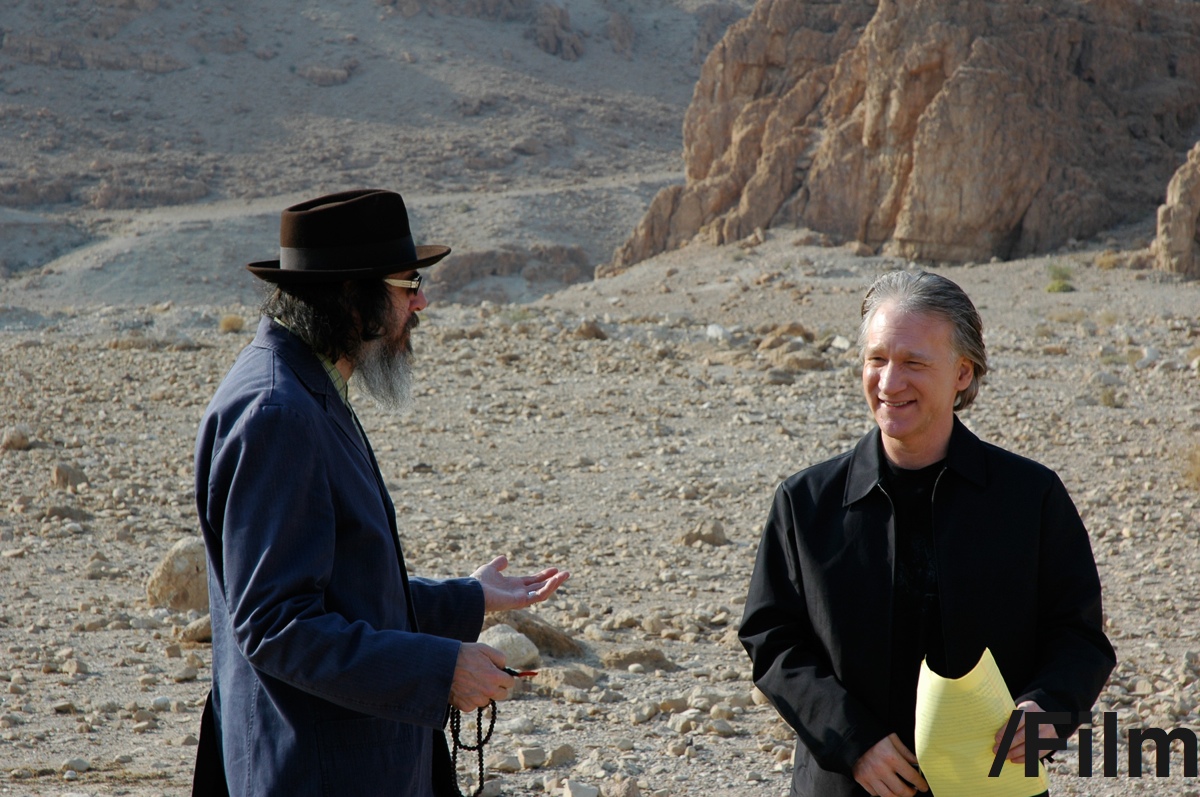 gin with. Of course at some point the explanations of rationality end, and there is the unknown. The point of the movie is to admit that it actually is unknown, and show that those who claim to know, really don’t.
gin with. Of course at some point the explanations of rationality end, and there is the unknown. The point of the movie is to admit that it actually is unknown, and show that those who claim to know, really don’t.
In the movie, Bill Maher interviews people from a variety of backgrounds and religious faiths (from a former head of the Human Genome Project and the former Director of the Vatican observatory to a British rapper). Some hold more nuanced views than others. He listens and asks questions of people who staunchly believe in literal translations of age old texts even when their beliefs scientifically absurd, and has some interesting (and comical) conversations. My favorite interview by far was with a very rational Vatican priest who happily admitted that Jesus’ birthday is not on December 25th and the Catholic church has absolutely no idea when it really is.
Time magazine recently named Balbir Singh Seechewal amongst its “Heroes of the Environment 2008.” The acknowledgement highlights the work of activists such as Balbir Singh and shows how their passion and innovation can positively impact the environment. Balbir Singh is described as “the Sikh who cleans the corrupted rivers of India,” and he is accoladed for his work of cleaning the historic Kali Bein river. The 99-mile-long river, in the Hoshiarpur district, is considered historically significant because Guru Nanak Dev Ji was said to have received enlightenment after taking a dip in the Kali Bein river. However, due to years of neglect, the river has become a containment of waste,
Over the past couple of decades it was reduced to a filthy drain into which six towns and more than 40 villages emptied their waste. Parts of the river dried up, leaving neighboring farmlands parched. Its polluted waters also seeped underground, contaminating the groundwater and causing lethal diseases.
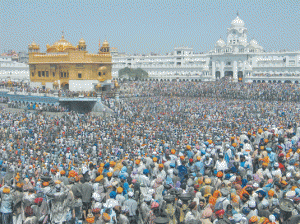 In 2000, Balbir Singh and inspired volunteers decided to use the concept of kar seva (voluntary service) to physically clear the entire riverbed and build riverbanks and roads alongside the river. In addition, they educated the locals via a public-awareness campaign on how to keep the river clear of waste. Today the river is not only cleared of sewage, but the natural springs have been revived and the river is once again flowing.
In 2000, Balbir Singh and inspired volunteers decided to use the concept of kar seva (voluntary service) to physically clear the entire riverbed and build riverbanks and roads alongside the river. In addition, they educated the locals via a public-awareness campaign on how to keep the river clear of waste. Today the river is not only cleared of sewage, but the natural springs have been revived and the river is once again flowing.
As we join others in praising Balbir Singh and his volunteers for what they have accomplished with the Kali Bein river, I also want to highlight the concept of Kar Seva and take the liberty to ask if we do enough of it? The most famous examples of Kar Seva occurred at the Darbar Sahib in Amritsar. I have seen pictures and videos of the last Kar Seva which occurred in Amritsar – and I have to admit, I don’t think words can describe the power of those images.
We seem to be pre-occupied with building new gurdwaras (yes, I know – that’s a whole other issue), but i mention it to simply say that as a community, we don’t do a very good job at sustaining our current establishments. Whether we speak of our historic gurdwaras in Punjab (both East and West Punjab) or if we think about our gurdwaras here in North America – there is a lot of Kar Seva which can be done. After seeing the images of Kar Seva at the Darbar Sahib, it is amazing to me how our community can mobilize itself to such an extent and peform such an incredible act. And yet, in many communities and at many gurdwaras, we struggle with keeping the kitchen clean or the trash picked up. Can Kar Seva exist outside of Punjab? It just makes you wonder….
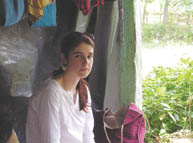 In an article published in the academic journal Ethnic and Racial Studies, last year, a PhD student in political science, Marie-Eve Reny makes a comparative study of political mobilization amongst the Sikhs of Punjab and the Uyghurs of Xinjiang in China.
In an article published in the academic journal Ethnic and Racial Studies, last year, a PhD student in political science, Marie-Eve Reny makes a comparative study of political mobilization amongst the Sikhs of Punjab and the Uyghurs of Xinjiang in China.
The Uyghurs are a Muslim community of Turkic descent in Western China. Many in the region have been fighting for their independence from China to establish Uyghurstan.
For her abstract, Marie-Eve Reny writes:
This article examines the reasons why the politicization of language has not been translated into disruptive forms of ethnic mobilization as opposed to the political salience of religion among the Uyghurs in Xinjiang throughout the 1990s and the Sikhs before and after the creation of Punjab in 1966. The article argues, from a structural-rationalist perspective, that language-based claims in Xinjiang and in Punjab have been accommodated by the respective central governments to a larger extent than religious claims have. Accommodation has taken the form of particular policies as well as greater incorporation of minority elites on the basis of language, which have in turn significantly reduced the possibilities of anti-regime sentiments and the incentives for disruptive forms of pressure on the basis of linguistic claims among the minority group. Religious claims have, however, not been accommodated in a similar way.
Yesterday a friend sent me a link to a fascinating episode of a Discovery Channel program. The “Weapon Masters” series looks at various pre-industrial weaponry and their historical development, usage, and production. For the “entertainment” value, it pits traditional usage against a ‘pimped’ up version using modern machine-technology.
The show’s summary states:
Weapon Masters explores the history and science of ten weapons of the ancient world. Hosting the series is internationally known weapons expert and historian, Mike Loades. In each hour-long episode, Mike travels to a different international location to examine one particular ancient weapon and learn first-hand about the cultures where the weapon was used. He is assisted by an expert who demonstrates the techniques behind each weapon. He then challenges his co-host and master craftsman, Chad, to improve upon it using modern manufacturing techniques and materials. [link]
In a recent episode, aired in England, the subject was the quoit or Sikh Chakkar / Chakkram.
http://video.google.com/videoplay?docid=5547025680137386480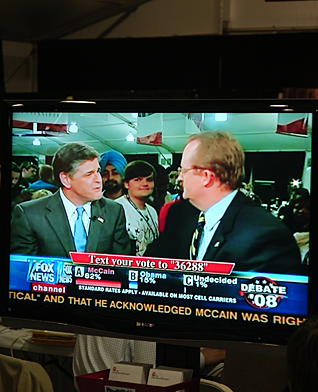 Were you watching the Presidential debate last Friday? Did you catch flashes of a sardar in a blue turban? I assume that anyone who did was equally as surprised as I was (though happily so). Well, who is the mystery man? He’s Arvinder Singh Kang, a twenty five year old who was the only Punjabi, and the only Sikh at the University of Mississipi when he came from Punjab to do a graduate degree.
Were you watching the Presidential debate last Friday? Did you catch flashes of a sardar in a blue turban? I assume that anyone who did was equally as surprised as I was (though happily so). Well, who is the mystery man? He’s Arvinder Singh Kang, a twenty five year old who was the only Punjabi, and the only Sikh at the University of Mississipi when he came from Punjab to do a graduate degree.
I came to the U.S. in the fall of 2005, as a graduate student at the University of Mississippi. From a proud Sikh family, I was the first kid from my village and from my maternal and paternal lineage to come to America for studies.
I brought twenty-something Puggs (turbans). I knew Japji Sahib by heart and had been exposed to Sikh history more than I had been to comics. All through my undergrad years, I had taught my juniors how to wear a turban. There was no doubt, whatever the circumstances might be, I would always be a Turbanator!
While boarding a plane from London’s Gatwick Airport, I sat beside a Sikh girl living in Houston who was born and raised in London. “…So it’s going to be hard to keep a turban in university”, she said in a lovely British accent.
“Much nee te kuch nee!” (What’s a man without a mustache) I had quipped. [link]
You can read more from Arvinder at Sikhchic.
Though this may not be the best analogy, I’m going to make it. It seems the Congress party in Haryana made the demand for a separate Gurdwara committee, in order to mobilize Sikh votes in their favor (at least according to one news source).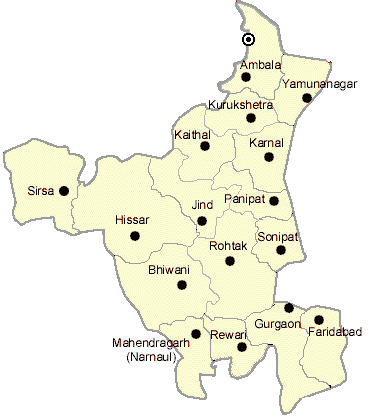
What is also well known is that Haryana’s Sikh vote has traditionally been mobilised by the SAD(B) for Devi Lal and then his son Om Prakash Chautala’s party. After 1984, the anti-Congress vote headed in that direction even more. By all accounts, the 2005 Assembly elections — also the one in which the Congress manifesto included the demand for a separate gurdwara management body for Haryana — constituted a break in the story. According to a CSDS survey, 50 per cent of the Sikh vote in Haryana went to the Congress in 2004, and only 35 per cent to Chautala’s INLD. [link]
And Sarah Palin- as qualified as she may be- was not selected to run as Vice President because of her outstanding qualifications, but for her token status as a woman. It was hoped that she would fulfill the dreams of Hillary supporters who wanted the glass ceiling in the White House shattered. (From what I’ve seen in the polls though, this doesn’t seem to have worked. The women who rallied behind Hillary don’t want a token representative.)
 This post is sort of dedicated to P.Singh. Let me first begin by saying that I agreed with ALL (and I use that word only after re-reading all of his comments) of the points that he made in a prior post (not all of his comments in other posts, but I digress….).
This post is sort of dedicated to P.Singh. Let me first begin by saying that I agreed with ALL (and I use that word only after re-reading all of his comments) of the points that he made in a prior post (not all of his comments in other posts, but I digress….).
However, I did want to revisit the topic of Dr. Pashaura Singh in light of some more news, posit a contrarian viewpoint based on an academic article, and then revisit the question of endowed Sikh chairs.
Update on Dr. Pashaura Singh
On Friday of last week, Sikhs throughout California organized buses down to the UC Riverside campus to protest Dr. Pashaura Singh’s hire as the chair of the endowed Jasbir Singh Saini Chair in Sikh and Punjabi Language Studies. While newspaper articles stated that over 300 people were in attendance, my own eye-witness sources claim that it was in excess of 500.
Earlier today I stumbled on this article in the Montreal Gazette detailing the suspension, and now calls for a speedy trial, for a Sikh boy accused of assault:
The teenager made his first appearance on the charges in Montreal Youth Court yesterday where he pleaded not guilty to three counts alleging he used a kirpan, a Sikh religious object that resembles a dagger, to threaten his schoolmates.
This case comes on the heels of another landmark Quebec case in which Canada’s Supreme Court unanimously voted to protect the right of Sikh school children to wear the kirpan (with some limitations on its use) in 2006.
But did the boy actually draw, or use, his kirpan during the argument? At first blush, it sounds like this was a schoolyard disagreement, but if the boy drew his kirpan it would be incredibly inappropriate, both under dharmic understandings and under school policy. But on reinspection, it’s unclear if this incident actually ever happened, or if this is a racist reaction against the kirpan. The boy’s lawyer, the same man who argued the Supreme Court case for accommodation of the kirpan, believes the reaction is racist:
Grey accused the Montreal police and the Marguerite Bourgeoys school board of “overreacting.” He also said a large part of Quebec society has never accepted the Supreme Court’s decision.
“I think that what we’re witnessing – it’s my opinion and the court will decide – is a deep bias against the kirpan that has never died in Quebec…”
If his lawyer is correct, then this brings up a larger issue: how do inclusion policies and values translate on the ground if a region or group is hostile to accommodation?
Legal protection of the kirpan is vitally important and relevant and worth protecting, but, if this incident did not take place, how many Sikh children will be pressured, harassed, and suspended from schools for exercising their right to practce their faith? In this case, the school board is not an advocate for the Sikh child (and in the previous kirpan case, when the school drafted an accommodation policy it was invalidated by the school board as well); if that democratic channel fails, then how can we support families in this position?
In the aftermath of the September 11, 2001 terrorist attacks, Muslims and Arabs in America engaged in various efforts to respond to the post-9/11 backlash. 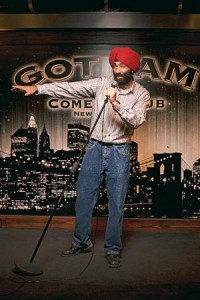 For example, in the halls of Congress they advocated against discriminatory security measures and in the courts of law they pressed allegations of employment discrimination and airport profiling.
For example, in the halls of Congress they advocated against discriminatory security measures and in the courts of law they pressed allegations of employment discrimination and airport profiling.
Muslim- and Arab-Americans also turned to another, perhaps less conventional forum: stand-up comedy clubs. For example, a comedy show, “Allah Made Me Funny,” was “an attempt by a group of American Muslim comics to counter the negative stereotypes and attitudes about Muslims and Arabs by poking fun at themselves, their communities and the prejudices they face.” [Link; see also here, here, and here.]
The latest edition of Newsweek contains an article by one Sikh, Narinder Singh, regarding his attempts to use comedy for the same purpose.
Heads-up friends, the season of the “Spinning Wheel Festival” is about to begin across North America this autumn. Celebrating Sikh films and art, the first stop will be in New York City on Saturday, October 04, 2008 at the Asia Society & Museum (p.s. that’s next Saturday). Buy your tickets NOW! The wonderful Rabbi Shergill will be performing at the opening gala (yes I am really biased here … I heart Rabbi Shergill) and DJ Rekha will be literally “spinning” at the after party.
Films a the NYC festival will range from documentaries on Pahelwani (i.e. Panjabi wrestling) and Kaba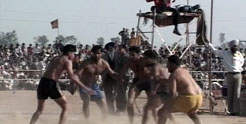 ddi-playing Canadian police officers to issues affecting the Sikh community from 1984 and post-9/11 hate crimes. There will also be short and feature films. For example, one on a young boy’
ddi-playing Canadian police officers to issues affecting the Sikh community from 1984 and post-9/11 hate crimes. There will also be short and feature films. For example, one on a young boy’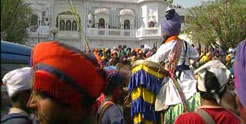 s struggle to keep his hair while his family fears the obstacles he will encounter and another on “… a young Sikh doctor struggling with the inequities of the American Health System and ultimately his own identity”. The Holy Duels of Hola Mohalla is a film looking at the Khalsa Panth.
s struggle to keep his hair while his family fears the obstacles he will encounter and another on “… a young Sikh doctor struggling with the inequities of the American Health System and ultimately his own identity”. The Holy Duels of Hola Mohalla is a film looking at the Khalsa Panth.
The films seem interesting both in content and presentation. The stories are grounded in the realities many of us encounter everyday. You can get a full listing of the films and their synopses here.
In the past, I have attended the “Spinning Wheel Festival” at one of its many North American stops and found it a great space for artists and art-enthusiasts to be exposed to Sikh creativity. I remember there being a panel discussion with the directors and the audience. We don’t have too many of these creative opportunities in our community even though we spend plenty of time and space advertising foreign medical schools in Poland, China, and the Caribbean.
I have found that some films are really hit or miss at these festivals, but it’s expected sense the focus is on cultivating and inspiring creativity; while, building a permanent Sikh film festival for years to come. Cash prizes are awarded to the “bests” in various categories. I have been told that the listing and quality of films varies across the different North American stops.
At the end of the day why not go, especially if it’s close by. I personally think it’s worth a visit as an act of supporting Sikh arts and learning about the various issues affecting our community. Sometimes we get too caught up in our own worlds and don’t realize these issues are taking place or we are in amidst of them and they become normal parts of our lives leaving very little room for reflection or exposure to others’ perceptions. Thus, it’s an  opportunity to get a fresh/new look at various issues.
opportunity to get a fresh/new look at various issues.
Lastly, the arts, from painting and photography to films and music, are our community’s soul! They help us speak in ways we can’t always articulate. So go save your soul and attend a Sikh artistic event! 
Okay, enough of the attempt at convincing … the other North American stops will be:
- Toronto, Canada from October 10-12, 2008 at the Isabel Bader Theatre.
- Hollywood, California from November 14-16, 2008 at the Writers Guild Theatre.
Are ya’ll thinking of going? What have your experiences been at the various Spinning Wheel Festivals? Does anyone know of other North American stops?
p.p.s. The Toronto and Hollywood poster is really interesting isn’t it … a conversation in of itself!
[Joint post by Singh and Reema]
The plot is thick. Nearly 100 million Phillipine pesos are at stake (roughly $ 2.2 million USD). Multiple groups of god-father like figures control entourages of loyal henchmen. Money is being used for unauthorized purposes, and powerful figures have put competitors out of play – risking not just the money, but [dun dun dun]…their lives!
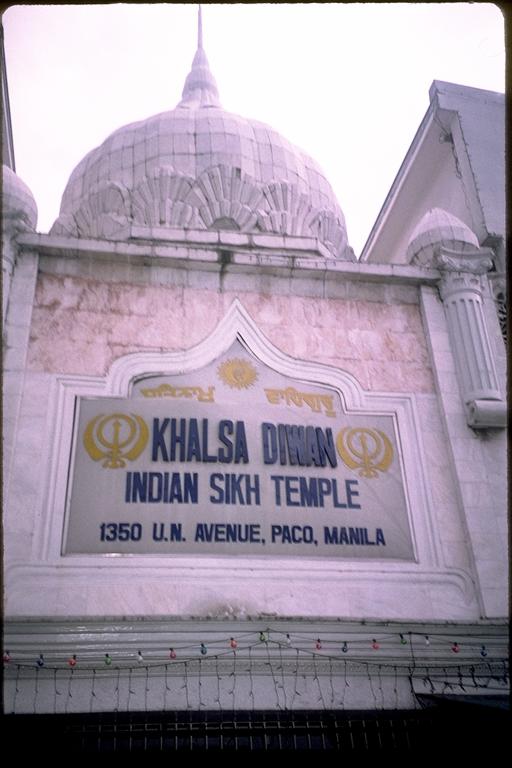
Is this:
(a) The set of Al Capone?
(b) A government paramilitary force under a dictatorship?
(c) The Punjab Police?
(d) Or is it just the story of a gurdwara?
You guessed it: the answer is (d)!
This is the set for the latest episode of “Who Wants to be a Pardhaan (President of the Gurdwara),” and it takes place in Manila, where a battle for control of the local guru ghar has been waged for years. We had heard of this type of thing being publicized in the West (Europe and the Americas), but why should the Phillipines be any different – and undoubtedly this story has just as much drama and un-Sikh-like behavior as any we have heard. It goes something like this:
2004: Bansal became Gurdwara president following a court-supervised elections. After coming into power, he looked into organization’s assets and found that Amardeep’s group (the old committee) had siphoned off P30.6 million from Gurdwara donations to a new corporation they had created—Khalsa Diwan (Sikh Religious Association) Inc.
For many of us Sikhs of Panjabi-background, those Sikhs that chose to embrace Sikhi (often termed as ‘goray Sikhs’, but by no means are all of them of such ‘gora’ background) are sometimes seen as an enigma. Too often stereotypes and easy labels such as ‘hippie’ or ‘weird’, knee-jerk opinions on ‘yoga’, or even a certain ‘guilt’ in terms of our own relationship with our Guru tend to be expressed in hushed tones. 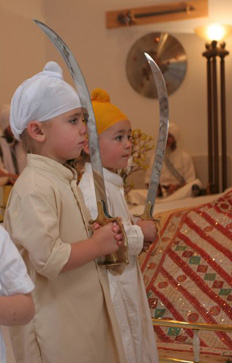 However, such labels only dehumanize those that we should be most embracing as brothers and sisters of a shared Guru.
However, such labels only dehumanize those that we should be most embracing as brothers and sisters of a shared Guru.
A recent article in a local Surrey newspaper recently has me re-thinking how as a Sikh community we can continue to strengthen our Qaum. Reading about Hari Nam Singh Khalsa’s own evolution was not only inspiring, but also a point for reflection.
The Oakville, Ontario resident is the host of the only English-language program on Canadian television that provides knowledge about Sikhi. His “Insight into Sikhism” airs on Saturday mornings throughout Canada (you can click here for Canadian times and channels). On the show’s website, the program’s purpose is described as:
Each week, host HariNam Singh Khalsa explains aspects of the Sikh religion and its relevance to modern day issues. Insight into Sikhism introduces the core principles of Sikhism in a simple and basic format in English for everyone to understand. HariNam Singh’s mission is to spread the universal teachings of Sikhism to people of all faiths.[link]
Although I have never seen the show (if you have, please do comment and let us know your thoughts about it), it seems like a remarkable and much-needed project.
A delegation of representatives for the PSGPC traveled to the U.S. and UK to discuss congregational needs, socioeconomics, and Muslim-Sikh relations in Pakistan [ed note: forgive the confusing grammar from the news source; the translation is imperfect].
The delegation did quite a bit of fundraising, and they stopped to check in with several Sikh “community leaders” throughout California, and elsewhere. Largely these were founders or heads of private non-profits, not congregations. It’s hard to discern what actually happened from the news coverage, which focused on explaining “those wacky” Sikhs. However, the group attempted to bring special attention to the disparities in achievement, etc., between Pakistani Muslims and Sikhs.
I finished the article with many more questions than when I started reading it; Why did the committee chose to travel to those two regions? Why were so many of their questions fixated on the ritualistic veins of Sikhi that have begun to penetrate our communities? How did they pick who to visit on their trip? What is the status of Pakistani Muslim-Sikh relations and disparities, today?
Did you hear about this tour from anyone? If so, what did you think?
So recently I came across a blog about all the “Stuff Korean Moms Like”. A Korean girl, Chiyo, who loves her KM (Korean Mom) decided to create this blog “to share the joy and dread of KM”. As I went through the list … I kept thinking about our own PSM’s (Panjabi Sikh Moms) … now now don’t think it’s funny to call our mummies’ PMS that actually stands for Panjabi Male Syndrome!
As I went through the list … I kept thinking about our own PSM’s (Panjabi Sikh Moms) … now now don’t think it’s funny to call our mummies’ PMS that actually stands for Panjabi Male Syndrome!
From corningware to marrying people off and stank eye … I found many similarities between KMs and PSMs (although the differences were stark … I don’t even think many PSMs know what redbean is let alone love it. And when it comes to Jesus … let’s just stick with the Gurus and Waheguruji)!
Inspired by Chiyo’s blog on Korean Moms, let’ start our own list of “Stuff Panjabi Sikh Moms’ Like”! I will begin …
- Tupperware (i.e. I am not just talkin’ about Rubbermaid … I mean sour cream and whipped butter dabhaa). Over time this Tupperware becomes yellow from all the haldhee in sabjis … but soak it in the sun and most of the stains go away. Slowly over time old ones are replaced as new ones are collected.
- Corningware (do I really need say anything more … I think Chiyo’s explanation resonates perfectly with PSMs).
- Zee TV, Sony TV, and Alpha Etc. Punjabi nateekhs (what’s your mom’s favorite soap opera …).
- Noon Dhani (i.e. the steel container with small steel bowls and spoons for all their spices).
- Dhahee (i.e. homemade yogurt … sorry I personally can’t stand the boxed stuff after growing up on my mom’s delicious freshly made dhahee).
- Outrage at the rising cost of Ataa (i.e. flour that is commonly bought at the Indian store to make roti).
- House-walls that are painted hospital white … look how clean and simple they look. The rooms feel much more lighted with this color.
- Overstuffing Family And Friends With Food … lai if they leave your house without a food-coma, they did not have a good-time.
- Cooking your favorite Panjabi dish when you come home from college. It’s a sign of how much she missed you.
- The ten Gurus’ pictures, particularly those of Guru Nanak Dev Ji and Guru Gobind Singh Ji, are the number one home-decorating items.
Please add to the list ( it’s in no particular order)! What do you think Panjabi Sikh Mom’s really like? I know many of you must have your own favorites! 
Disclaimer: Please keep it clean, respectful, and hate-free … I really should not have to say this, but unfortunately in the virtual world people often display a “holds-no-bar” attitude when commenting on issues like this one.
This day marks the 221th anniversary of the signing of the U.S. Constitution.
No matter how much we argue about the details of its meaning today, in the opinion of many, the Constitution signed in Philadelphia on September 17, 1787 represents the greatest expression of statesmanship and compromise ever written. In just four hand-written pages, the Constitution gives us no less than the owners’ manual to the greatest form of government the world has ever known. [Link]
To commemorate this historic day, the U.S. Congress designated September 17 as “Constitution Day” and required all schools that receive federal financial assistance to “provide some educational programming about the U.S. Constitution on or around Sept. 17[.]” Despite the brilliance of the American constitutional system and the congressional mandate for schools to study the Constitution on at least one day, ignorance of the American government remains high. For example:
- When asked to name two of Snow White’s Seven Dwarfs and two of the nine U.S. Supreme Court Justices, 77% of Americans polled were able to identify two dwarfs, while only 24% could name two Supreme Court Justices.
- 73% of those polled [were] able to name all three of The Three Stooges, while only 42% could name the three branches of government. [Link]
Further, more American teenagers
- know the Fresh Prince of Bel-Air than know the Chief Justice of the Supreme Court (94.7% to 2.2%)
- know which city has the zip code “90210” than the city in which the U.S. Constitution was written (75% to 25%) [Link]
These and similar statistics should alarm Americans and they reflect the need for greater civics education in American schools. But we should not think that this is a concern from which Sikhs are exempt.
We have had a lot of discussion about the Sikh identity here on TLH, so it is no surprise that when I saw this movie poster I immediately wanted to bring it to your attention.
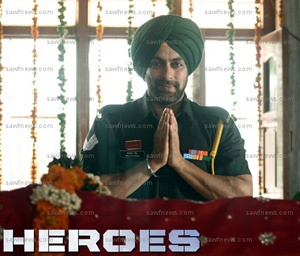 Bollywood is doing it again – another movie with Sikhs. But instead of what we have seen in the past with Sikhs often portrayed as unflattering villains and goofballs, it seems that the trend now is to cast people in Sikhs roles where the Sikhs are the heroes. I suppose it is partly in that spirit that the movie is called “Heroes.”
Bollywood is doing it again – another movie with Sikhs. But instead of what we have seen in the past with Sikhs often portrayed as unflattering villains and goofballs, it seems that the trend now is to cast people in Sikhs roles where the Sikhs are the heroes. I suppose it is partly in that spirit that the movie is called “Heroes.”
Heroes is about two friends who journey through India meeting everyday heroes, at least one of whom is a Sikh. But that is not the part that interested me of course. The interesting part is not the story line, but all of the press that Salman Khan (the actor who plays a Sikh hero) has gotten for his attempt to play a real Sikh.
Salman Khan [is] seen in a Sikh makeover for the first time ever and he makes a good looking jatt Sikh with a beautifully tied turban. He grew his beard for three weeks before the filming for an authentic bearded Sikh look. Source.
I think this is probably the first time that I have heard this happening. Although, I think actor Sunny Deol may have grown his own beard for a couple of his roles as a Sikh – it has never been so explicitly commended or publicized. I’m not sure how I come down on this, but all the press does point to a deliberate effort by Bollywood to NOT-offend Sikhs, which I think is a positive move on the film industries part.
